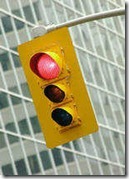Every few years a major "new" study is released by the auto insurance industry showing that red light cameras make intersections safer. That is what the headline usually says, at least.
Traffic intersections with signal lights can be enforced using cameras that detect when a car runs a red light. The automated camera takes a picture of the driver and the license plate and the traffic signal showing red and then mails a traffic ticket to the driver’s home address as listed on the vehicle registration. The idea, of course, is that people will respect red lights more and not run them as often, thereby reducing crashes and increasing safety.
Does it work?
Traffic Statistics and Vested Interests
 The unfortunate fact is that many Americans are woefully ignorant when it comes to math and statistics. Most people can add and subtract, of course, and savvy shoppers can figure out percentages in their head, but when it comes to analyzing data, most adults just throw up their hands and say, "I was never any good at math."
The unfortunate fact is that many Americans are woefully ignorant when it comes to math and statistics. Most people can add and subtract, of course, and savvy shoppers can figure out percentages in their head, but when it comes to analyzing data, most adults just throw up their hands and say, "I was never any good at math."
Ignorance and misinformation are the most powerful tools available for controlling the thoughts and beliefs of others. Statistics have long been a favorite business strategy to manipulate the public.
Statistics used to garner public opinion work in the same way that a magician does. By distracting you with something showy and flashy over here, you look away from where something is really happening, allowing the illusionist to trick you into thinking that you have seen something that didn’t really happen.
The flashy noise statistics use is what newspapers like to print in their headlines. In this case, "Study finds red light cameras cut fatal crashes." No doubt, the study’s authors would have preferred, "Study finds red light cameras save lives," but it’s close enough.
The flash is the news that red light cameras are good. The purpose of the study is to give politicians cover for installing highly unpopular red light cameras. When people get angry and demand that the cameras be removed, or never installed in the first place, the politician can hold up this study as a shield and say that he is only thinking about the safety of people.
The "trick" occurs within the study. This research in no way proves or even suggests that red light cameras reduce the overall number of accidents at intersections with traffic lights. It also does not say that there are fewer injuries, nor does it say that photo enforcement of red lights makes intersections safer. All of that gets inferred by people who are not paying attention. The only thing the study says is that at intersections with red light cameras the number of FATAL crashes is reduced.
Does that make red light cameras a good traffic enforcement tool that make people safer?
That depends on all of the data that no one bothered to include.
If the number of fatal crashes is reduced slightly, but the number of crashes where someone is hospitalized increase dramatically, then red light cameras do not make intersections safer. In fact, in that instance one could say that red light cameras actually make intersections more dangerous.
The key to understanding research and statistics is knowing who is behind them. It doesn’t matter that people produce research that supports their point of view. That is merely good science. If you believe something, you should be able to produce facts to back it up.
The problem comes when there are two kinds of research studies and the only ones that support an idea are the ones that are paid for by the people who want to believe, while all of the other studies say something different. Think about how the tobacco industry spent years producing research showing that nicotine was not addictive, or that the facts were inconclusive, while everyone else in the world was coming to a different conclusion.
In this case, the insurance industry is the only one who ever produces research showing traffic cameras are safer. Everyone else, including government researchers and academic researchers either find inconclusive data or worse, that traffic light cameras actually increase the number of overall accidents at intersections.
To find out why, one need only look at the fact that all research about red light cameras agrees on.
Red light cameras substantially increase the number of traffic tickets generated at intersections with traffic signals.
Who gets to charge higher insurance rates whenever anyone gets a traffic ticket?
Image courtesy of Microsoft Office clipart.